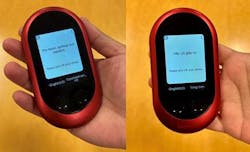Transportation Security Administration (TSA) officers are testing the use of new hand-held language translation-interpretation devices in an effort to support a more positive security checkpoint experience for individuals who are limited English proficient, international travelers and individuals who are deaf or hard of hearing or who are blind or have low vision.
The goal of this pilot is to allow TSA to evaluate the viability of these devices by assessing the ease and effectiveness of use and its impact on checkpoint operations.
“We hope that this will turn out to be a valuable tool for our officers to provide guidance to passengers who might not speak English,” explained Gerardo Spero, TSA’s Federal Security Director for Philadelphia International Airport. “For example, it will help us to explain in the language that the traveler understands, that we may need to open a carry-on bag for a search.”
The device is smaller than a mobile phone and contains a library of 83 languages. A TSA officer or a traveler can speak into the device and it will translate the message into the language that is selected. The device will audibly repeat the message into the chosen language for the traveler and it will appear on the screen for travelers to read if they are deaf or hard of hearing.
TSA has deployed five units to be used at checkpoints in Philadelphia’s international terminals A-East and A-West, and also at its busiest checkpoints in terminals B and DE. Since the rechargeable units work via Wi-Fi or data connection, they can easily be moved to any checkpoint lane where they are needed because they do not need to be tethered to an electrical outlet. “That agility is extremely valuable to us,” Spero explained.
In the short time that the units have been in use, TSA has seen the benefits of the units as well as a few challenges, such as the use of colloquialisms. For example, the term “pat-down” does not translate accurately into all languages and instead TSA officers may need to use different words to explain that a pat-down needs to take place.
TSA can pre-program common advisements that TSA officers use in typical checkpoint conversations. The device can keep up to 10,000 translations that are “favorites” and commonly used. Software updates can be downloaded to add languages and words to the vocabulary library. Some foreign languages have specific dialects and other nuances. For example, the units distinguish four types of Spanish--that spoken in Spain, Argentina, Columbia or the United States.
Checkpoints can be noisy places and as a result, TSA officials have learned that enunciating words into the device is important. For example, the unit may mistakenly translate the words “your coat” into “you’re a coat.” It is this type of information that TSA is gathering to help determine how to work around the ambient noise issues of a checkpoint.
“The field testing of these units is one step that we are taking to improve our communication with a broader traveling population and further enhance the customer experience,” explained Jose Bonilla, TSA’s Executive Director of the agency’s Traveler Engagement Division. “The results of this field test will allow us to evaluate the viability of a small, stand-alone communication device at our checkpoints by assessing the ease and effectiveness of use and its impact on checkpoint operations.”
“This has potential to be a game-changer for travelers who are not fluent in English who come to our checkpoints,” Spero said. “It will ease their travel experience. Already we are seeing a positive impact.”



